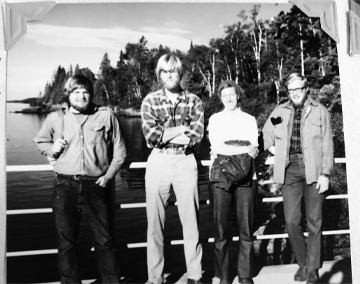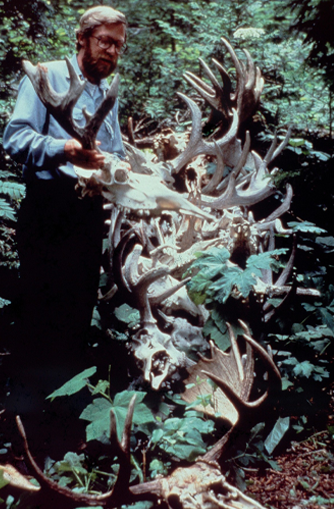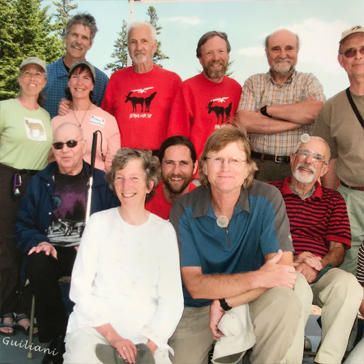Peterson Earns FNR Lifetime Achievement Award
A National Geographic article on Durward Allen’s Isle Royale Wolf and Moose Research Project caught the attention of a young Rolf Peterson. The project, which began in 1958, was proposed to be a 10-year study, meaning Peterson would just miss being a part of it as he graduated from Minnesota-Duluth with a degree in zoology in 1970.
As fate would have it, Allen decided to continue the project past 10 years and was in search of a graduate student. Peterson saw the news on a TV documentary about wolves and the rest is history.
“I had been aware of the Isle Royale study,” Peterson recalls. “It was billed to be a 10-year study, so I thought it was over in 1968. That was according to a National Geographic, so of course it was true, right? But actually, Durward just threw that out there initially as a goal and by the 10-year mark he realized they were just really getting their feet wet in a lot of things, so unbeknownst to me he decided to pursue another graduate student. I actually heard about it on a TV program about wolves that featured, among other things, the Durward Allen study and Isle Royale. Thanks to National Geographic, MGM and television I ended up at Purdue.”
When Peterson completed his PhD in 1974, Allen retired and turned the research program over to his protégé, with the work transferring from Purdue to Michigan Technological University, where Peterson was named as an assistant professor of biological sciences in 1975.
Peterson remains at Michigan Tech to this day, serving as a research professor in the School of Forest Resources and Environmental Science since 2006 after stints as assistant professor of biological sciences (1975-1983), associate professor of biological sciences (1983-1987) and professor in the School of Forestry and Wood Products (1987-2006). In his tenure, Peterson has taught everything from vertebrate anatomy to human ecology to animal behavior to wildlife habitat management. He has advised 26 graduate students including eight PhD students.
“It all turned out extremely well,” Peterson stated. “Initially it was just an extremely exciting and enticing opportunity to study wolves and moose in the wild. I had been to Isle Royale a couple of times and it was a fabulous place, so there was no hesitation at all when I was given the opportunity to do a three or four-year study there for my PhD. What could be better than that? But then, once I got into it, I realized there was some fascinating science to be done there. As time goes on, it just continues widening the opportunities, so it has been a continual fascination for me.”
Allen’s original goal for the Isle Royale project was to figure out what it meant to have wolves in an island ecosystem, an isolated system where wolves were not being persecuted by people at all and where there weren’t animals coming and going all of the time. The research aimed to assess the wolves’ role in the ecosystem, and that holds true today.
Dave Mech, Allen’s first graduate student on the project, discovered that moose killed by wolves are a very, very small proportion of the total population and moose can readily escape wolves. The wolves rely almost completely on calves born less than a year before, and old moose that have lots of pathologies that are evident in their bones.
“There was really no good expectation that the project would last long and nobody had any idea what the initial findings were going to be,” Peterson said. “Nobody knew if the island was big enough to support a self-sustaining population of wolves, and in some ways it wasn’t because genetic viability requires occasional new animals coming in. Our science is really geared towards trying to figure out the past, especially the immediate past, to understand the wolf/moose dynamics. But our crystal ball is very fuzzy at best because of these unplanned events that seem to dictate what direction the wolves and moose are going. The whole wolf/moose dynamic is affected greatly by unanticipated, unpredictable events like a disease, for example. That’s probably our most important finding. That and the extreme selectivity of wolf predation, the fact that their numbers are controlled essentially by their food supply, so they are in some sense self-regulated.”
Wolves regulate themselves as most top carnivores do or they are regulated by disease and parasites. Research into moose health has been a large area of discovery over the years. Peterson explains that moose health is very similar to human health, including arthritis as a major crippler, and osteoporosis, which undermines the integrity of their bones, and tooth problems, which can endanger their lives.
For four years, Peterson was under contract with the U.S. Fish and Wildlife Service to work on wolf and moose research on the Kenai National Wildlife Refuge in Alaska.
“The work in Alaska involved a famous population of moose that hadn’t seen wolf predation for over 70 or 80 years and suddenly wolves showed up again,” Peterson said. “We were on the ground pretty fast to see what the wolves were doing in that moose system, and it pretty much followed exactly the same predation pattern as we see in Isle Royale, killing mostly old and young moose in a system where moose were heavily hunted. I didn’t learn anything fundamental about wolves and moose in Alaska that I didn’t already know, but there were some major techniques I learned, in terms of radio collaring and immobilizing wolves and moose, that came to be important later at Isle Royale.”
From 2003 to 2019, Peterson was a co-principal investigator or senior advisor for long-term ecological studies of wolves in Yellowstone National Park, funded by the National Science Foundation.
“Yellowstone was a phenomenal opportunity to be involved in perhaps the most important wildlife restoration of the 20th century,” Peterson shared. “The people that were in charge of that fieldwork had worked for me on Isle Royale so I was able to take advantage of connections there. I didn’t contribute in any major way, but I certainly learned a lot about wolves and elk in that system and became interested in an effect there, that these top carnivores, wolves, because they affect moose, also affect the vegetation. Essentially trees are able to grow because of the protection that wolves provide by reducing elk density. In Yellowstone, that was the biggest wildlife management controversy, the alleged overgrazing of elk when there weren’t any predators in the system. In the almost 25 years since wolves were restored to Yellowstone, the elk population has been reduced and that has meant some new dynamics for the vegetation, in particular aspen and willow, in the park. That’s a fascinating story and the experience at Isle Royale looking at these vegetation effects primed me for that work.”
In addition to wolves, moose and vegetation, Peterson’s research has also looked at a variety of species from muskrats and beavers to coyotes, black bears, and bats.
“Wolves get their noses in everything,” Peterson explains. “I have tended to work in national parks or national wildlife refuges where there are important protections and managers want to know the condition of wildlife populations because Congress has charged them to preserve wildlife and natural resources for the future. In many cases, these projects were perfect for graduate students to come in and in three or four years solve a problem or determine the status of major populations in a relatively short amount of time. It has been very gratifying for me to see students go on and do things I never did and make huge strides and advances in the field.”
During all of these projects, work pressed forward on Isle Royale, using a combination of the classic techniques employed by Durward Allen as well as the latest study techniques such as molecular genetics and wildlife telemetry to retain the consistency in data sets.
“A lot of the current research we do on Isle Royale uses exactly the same techniques that Dave Mech and Durward Allen developed over 60 years ago,” Peterson said. “The use of airplanes to find and count wolves was brand new in the 1950s and yet we rely on that heavily today. And in that whole period of time, there have only been three pilots that have flown those planes on Isle Royale. They are critical members of the research team. It’s nothing fancier than looking out the window and looking for and identifying wolf tracks. I make it sound easy, but it’s not. New technology can certainly address some things that were unavailable in the past, but consistency over time is a critical feature. We put citizen scientists to work looking for moose bones on the ground and that is another fairly low-tech approach to providing critical data for us.”
Over the years, Peterson has trained more than 1,000 volunteer citizen scientists to supplement his own time on the island, which began as a seven-week stay each winter and has evolved into seven weeks in the winter and six months in the summer.
The volunteers assist in discovering a pattern of moose mortality by hiking the island and looking for bones and carcasses, which can then be assessed for age, physical condition, and total number of deaths. Volunteers also take photographs to document the wildlife they see and the landscape.
“There’s no easy way to do that other than just walk around on the ground,” Peterson explains. “My wife and I used to do it and then we’d hire two undergraduates usually from Purdue or Michigan Tech. But then, in the late 1980s, Earthwatch, a new organization in Boston, devoted itself to recruiting members of the public to support field research. For 20 years they supported us by recruiting volunteers. We would take those people and put them in a group of five plus a leader and they would charge off for a week walking cross country. They’re backpacking and carrying everything they need for a week, so it is incredibly hard work, but it’s very rewarding. Some people keep coming back year after year. They are so good at what they do and there is a learning curve toward identifying bones laying 50 or 100 meters away. They do very well. It’s a genuine adventure. You don’t know what you’re going to find.”
Some of the volunteers have been helping Peterson on Isle Royale for 30 or 40 years. The oldest volunteer is 80 years old and he has been coming to the island for more than 30 years. In fact, there are so many long-time citizen scientists that Peterson has developed an alumni trip for those who have graduated from the hardcore week-long backpacking trip, and instead take day trips out from a central location. Peterson organized and supervised Earthwatch field expeditions from 1988-2008 and has done so for Moosewatch since 2009, bringing more than 50 volunteers to Isle Royale annually.
As Peterson looks back on his 40-plus year career on Isle Royale, he can’t help but remember the people who set him on this amazing journey.
“I had a chance to learn about wildlife management from pioneers in the field, Durward Allen and Charles Kirkpatrick,” Peterson reminisced. “They were nationally known long before I ever got to Purdue, so that was a quite rare opportunity, hearing about the history of wildlife management from the people who were responsible for it. Erich Klinghammer was an ecologist from the old world, from Europe. He had the seed of an idea to have an animal behavior facility near Purdue and ended up founding Wolf Park. He was on my committee and I learned how to do behavioral research from him. The veterinary school also was critical for me. I took a year-long sequence in physiology, the same one that the veterinary students took, and I have relied on that ever since. It helped stimulate an interest in animal health that has been really important for me all the way through.
“I also learned a lot from Dave Mech, who is the preeminent wolf biologist in the world. He started on Isle Royale in 1958 and has never stopped working on wolf research. I first met Dave in the early 1970s and we have maintained a very close relationship ever since. He actually arranged for me to go to Alaska and work on the Kenai Peninsula. He got me involved in that through the Fish and Wildlife Service and together we worked on some foundational studies relating to the survival of newborn moose calves. There is a pretty close-knit group of human researchers devoted to both moose and wolves that is incredibly useful.”
The only gap in data in the 63 years of research on Isle Royale is that from the 2020-21 winter season, when the global pandemic prevented the winter study, marking a regrettable hole that will always exist in the longest-running and most cited predator-prey study in the world. To keep the research going throughout the years, Peterson has collected more than $6 million in funds from the National Science Foundation, the National Park Service and National Geographic Society among others. In recognition of the longevity and importance of the research, the Wolf-Moose Project on Isle Royale was inducted into the Michigan Environmental Hall of Fame in 2014.
Peterson meanwhile has earned numerous awards for his work. He was given the Gulf Oil Conservation Award in 1982, making him one of just 10 professional conservationists recognized that year. His article “Of Moose and Wolves” published in the Lake Superior Magazine earned the Best Reporting Award from the Minnesota Magazine and Publications Association in 1999. He received the Burton V. Barnes Award from the Michigan Chapter of the Sierra Club in 2012 and garnered the Erich Klinghammer Award for contributions to wolf conservation in 2013. Most recently, in 2017, Peterson was named among Discover magazine’s “Heroes of Science,” as one of just three wildlife biologists mentioned, alongside Aldo Leopold and Jane Goodall.
Peterson has also been honored by all three of his alma maters, being named as a distinguished alumnus of the Academy of Science and Engineering at Minnesota-Duluth in 2005 and by the Purdue College of Agriculture in 2012. In 2014, he was named to the inaugural cohort of the Hall of Fame for Roosevelt High School in Minneapolis, Minnesota.
“Dr. Peterson’s research activities have been instrumental in publicizing wildlife research and conservation and thereby helping to educate the public about wildlife and specifically wolves, one of our most controversial animals,” adjunct professor and U.S. Geological Survey senior scientist David Mech said in nominating his colleague for Purdue Forestry and Natural Resources’ Lifetime Achievement Award. “However, maintaining and conducting the Isle Royale study has been only a small part of Rolf Peterson’s career. His life and career have been spent as a very productive and eminent wildlife scientist and ecologist, an academician, and educator.”
Peterson’s work has produced 158 publications and he has written two books – Wolf Ecology and Prey Relationships on Isle Royale (1977) and The Wolves of Isle Royale – A Broken Balance (2007). His research and photography have been featured in five documentary films, including Breakthrough: Return of the Wolves produced by the National Parks of Lake Superior Foundation in 2020, as well as numerous magazine and newspaper articles from National Geographic to Newsweek. Peterson’s reach extends well beyond the scientific community as The Wolves and Moose of Isle Royale Facebook page received 1.3 million visits in 2020 and his public outreach to visitors in the park alone has reached more than 20,000 people in the last five years.
“It is far more recognition than I deserve but I’m most appreciative for keeping on with the important work that I was introduced to by some of the leaders in the field of wildlife management,” Peterson said of receiving the Purdue FNR 2021 Lifetime Achievement Award. “When I went to Purdue, I was pretty naïve about a lot of very basic wildlife management aspects, so it was a real eye-opener to learn about the field from the pioneers. Many of the procedures and traditions in research and research administration I learned at Purdue have been critical in the decades since. It was a wonderful start, and, of course, my involvement on Isle Royale was facilitated by the Purdue experience. It’s been my whole life ever since, so all of the people that I’ve met and opportunities in research and teaching got their start at Purdue. It’s part of my fabric. The start I got at Purdue has weaved through virtually everything I’ve done since that time, so I appreciate the recognition of a lifetime achievement award and I’m most grateful for the help along the way from all of the Purdue community.”
Peterson will be honored with the Lifetime Achievement Award in a virtual ceremony on April 20 alongside Outstanding Young Alumni Award winner Dr. Obed Hernández-Gómez, Distinguished Alumnus honorees Dr. Robin Russell and Dr. Todd Atwood, and one fellow Lifetime Achievement Award winner.












